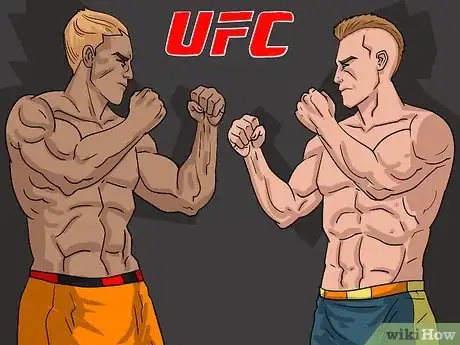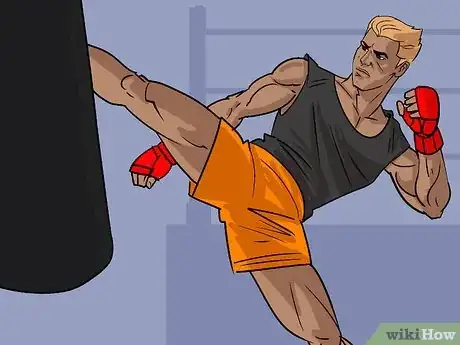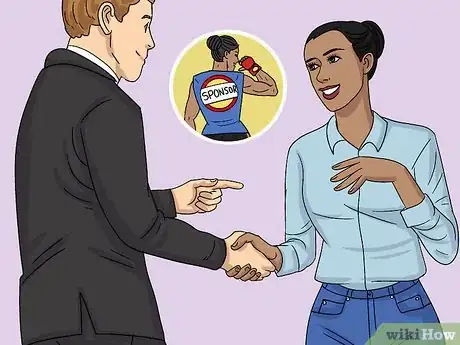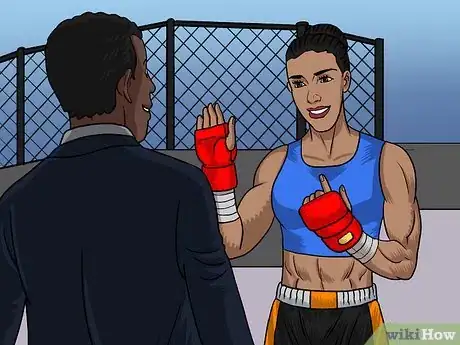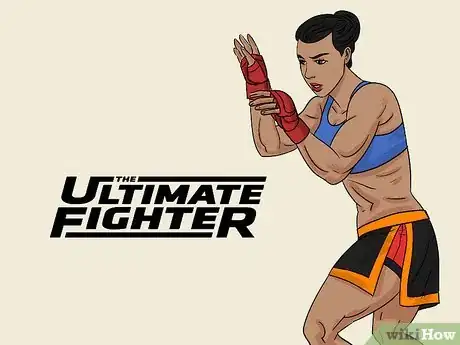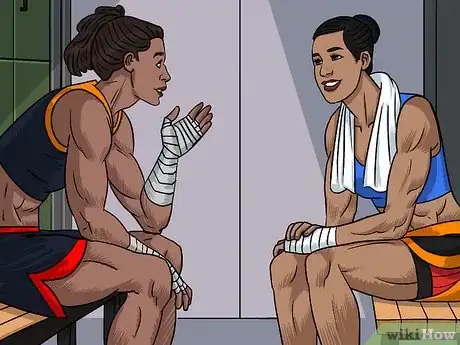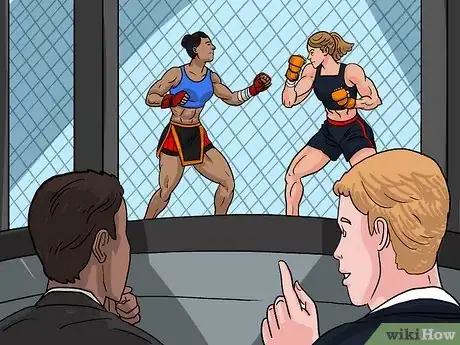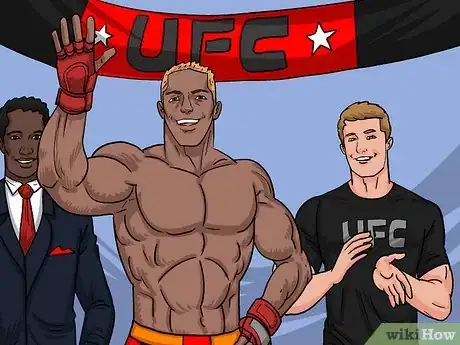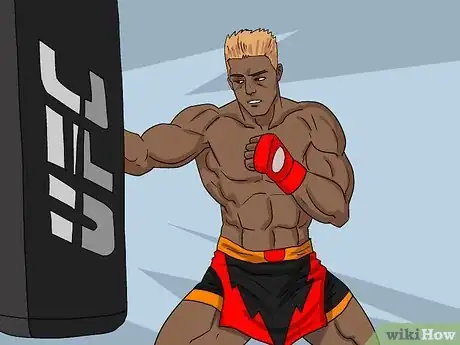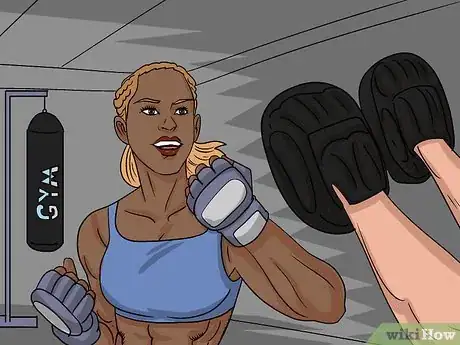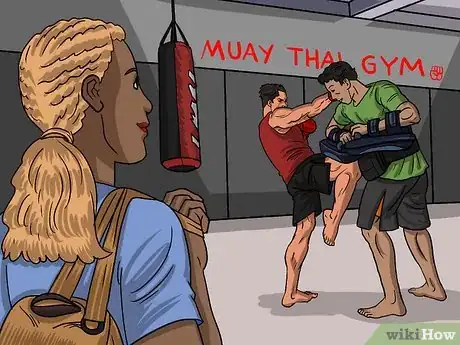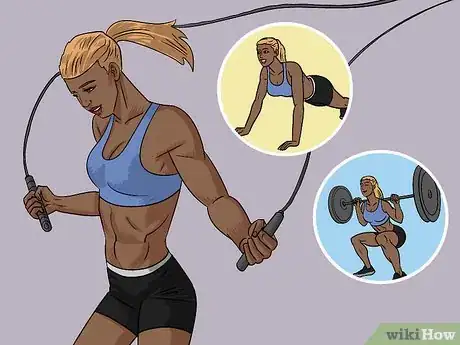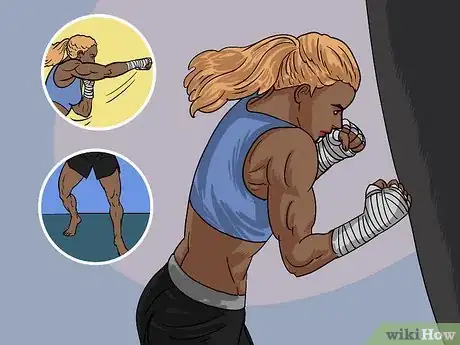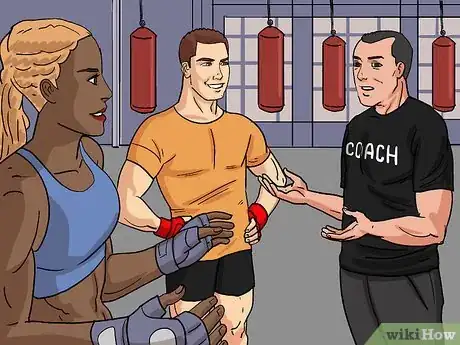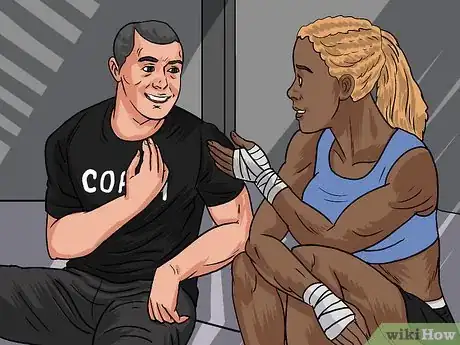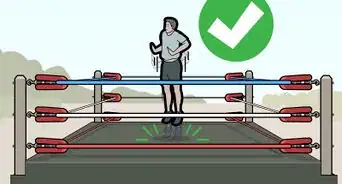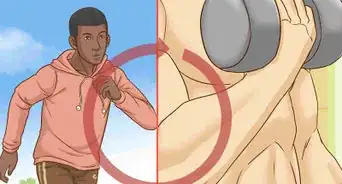This article was written by Derrek Hofrichter and by wikiHow staff writer, Kira Jan. Derrek Hofrichter is a Self Defense Specialist and the Founder of EVKM Self Defense & Fitness in Tempe, Arizona. Derrek specializes in Krav Maga, Personal Safety, and Boxing. Derrek is a Krav Maga Third Degree Black Belt, a Senior Certified Krav Maga Instructor, and a Krav Maga Alliance Executive Board, and Training Team Member. EVKM Self Defense & Fitness was named the 2014 Krav Maga Alliance School of the Year and the 2017 Best Gym/Workout Studio in Phoenix. Derrek was named as one of the top 30 Health and Fitness Leaders in Arizona under the age of 40 by The Arizona Republic and azcentral.com in 2018. He also holds a BA in Government Public Policy from Patrick Henry College.
There are 29 references cited in this article, which can be found at the bottom of the page.
This article has been viewed 29,289 times.
Are you a budding athlete who wants to make a name for yourself in mixed martial arts (MMA)? In the modern era, it’s not enough to only be a great fighter. You’ll also need savvy business skills to market yourself and get next-level sponsorships that’ll help you climb the ladder to the top. To let you in on what it takes to become an MMA pro, we’ve compiled answers to your questions on building a career as a fighter.
Steps
How do you get sponsored as an MMA fighter?
-
1Reach out to local business owners directly. Aim for companies whose products or content seems relevant to MMA, like sports equipment or apparel stores. Ask to meet the owner in-person and deliver a strong sales pitch about the stats on your online audience, who you are as a fighter and an individual, and what you have to offer for their company.
- Offer to plug their company on social media or wear their clothing in the cage when you fight. In return, your sponsor will pay you fees per appearance (usually a couple hundred to a thousand dollars).[7]
-
2Approach promoters/sponsors you meet at fights. If you’re finding it tough to get a local business to sponsor you, this method might be easier because you’ll know they’re already fans of the sport. To stand apart from other fighters, focus on building up your social media presence so you can show potential sponsors that people are starting to notice you.[8]
- Once you get sponsored (even by a small company), show loyalty and increase their commitment to you by pushing their content/product hard on your social media channels with multiple posts.[9]
How do you join the UFC and move on to bigger fights?
-
1Join through The Ultimate Fighter (TUF) reality show. If you show potential but don’t have a perfect record, you might be able to get a spot on The Ultimate Fighter by filling out an application when they send out a casting call.[10]
- You’ll need to be between 21-34 years old and have at least 3 professional-level fights under your belt.[11]
-
2Know a UFC fighter who can put in a word for you. If you have a mentor, training partner, or friend who is a UFC fighter, they might be able to help you get into the UFC by vouching for you and using their connections.[12]
-
3Get noticed by recruiters and coaches. This is the hardest way to get into the UFC, and it’s mostly based on luck.[13] First, you’ll have to win 6-8+ amateur fights. If you’ve built up a following on social media and if your coach has strong connections, scouts may come to your fights or your gym. If you meet the weight class criteria they’re looking for, you’ll be able to participate in one of their next pro fights.[14]
How much do MMA fighters make?
-
1By definition, as an amateur, you won’t be paid for fights. However, you may be able to make $300-400 through local promotions and sponsorships.[15]
-
2The median annual salary for pro MMA fighters is about $70,000. That salary comes from base pay for UFC fights, sponsorships, pay-per-view points (PPV), and bonuses from winning fights. Approximately a third of pro MMA fighters make six-figure salaries, while only a handful of superstars make millions. [16]
How do you start training?
-
1Join an MMA gym to get access to equipment and coaching. You don’t necessarily need to join a high-profile gym or club at this early stage. Still, it helps to try out a few clubs through free trials (if they’re offered) to check out the quality and condition of the equipment, as well as the general vibe of the people at the facility.[18]
- Look for equipment that’s well-cared for and people who seem respectful and considerate of others’ safety.
-
2If you can’t find an MMA gym, find a traditional martial arts gym. Ideally, find a studio that teaches Muay Thai, Brazilian Jiu Jitsu, or wrestling, so you can build up the fundamentals of striking and grappling that you’ll need for MMA.[19]
- Learn Brazilian Jiu Jitsu to get the best base for MMA because of its emphasis on grappling.[20]
- Improve your wrestling and judo skills to support your takedowns and ability to use leverage over your opponent.
- Practice boxing and karate or kung fu to boost your striking power and ability.
-
3Build your strength, speed, and endurance conditioning. Ditch aesthetically-focused exercises like bicep curls in favor of functional circuit training and plyometrics to increase your explosive power.
[21] Having the proper strength will set you up for success for the rigorous twice-a-day training that professional MMA fighters take on.[22]
-
1
- Start every workout with a 5-10 minute dynamic warmup.[23]
- If you don’t have equipment, do circuits with burpees, pushups, mountain climbers, and planks.
- If you have gym equipment (free weights and cable pulleys), incorporate kettlebell swings, cleans, Arnold presses, and full squats to develop your base strength and power.
-
2Practice solo drills and shadowboxing. While it’s essential to train with a sparring partner to gain fight experience, you can build up your fundamental skills through drilling.[24]
- Basic Punch Drills: Practice forward and backward 1-2 (jab-cross) combos or 1-1-2 (jab-jab-cross) combos while staying on the balls of your feet with your hands up high. Be sure to turn your hips to help carry that momentum into your punches.[25]
- Footwork Drills: Practice combining probing and retreating steps (forward and backward steps) with 1-2 combos. Switch your stance from time-to-time to practice footwork on both sides.[26]
- Cardio/Speed Drills: Set 15 second intervals and alternate between rest and hitting the heavy bag as fast as you can for 15 seconds with 1-2 combos or 1-2-3 combos (jab-cross-hook).[27]
How do you find an MMA trainer?
-
1Contact your local gym to see if they employ or recommend trainers. Ask the trainers about their coaching philosophy and/or read up on the club’s website to see if your values align with the coach’s.[28]
- Some coaches may have a “train hard all the time” mentality while others might focus more on overall well-being of their athlete. Choose the approach that fits your goals and lifestyle.
- Ask “How soon can I compete?” If the coach answers, “As soon as you want,” that tells you the gym probably doesn’t have your best interests and well-being in mind. If they tell you they’ll wait until you’re ready and safe, the instructor is probably good.[29]
-
2Check the coach’s credentials. It’s not necessary for your coach to have loads of competition experience (plenty of great coaches have never competed professionally), but if you’re looking to go pro, it helps to have a coach who has a strong fight record and former pro career.[30]
Community Q&A
-
QuestionI’m 15 years old. Is it too late to start MMA?
 wikiHow Staff EditorThis answer was written by one of our trained team of researchers who validated it for accuracy and comprehensiveness.
wikiHow Staff EditorThis answer was written by one of our trained team of researchers who validated it for accuracy and comprehensiveness.
Staff Answer wikiHow Staff EditorStaff AnswerNo! It's great to start as a teen since you'll have time to build your strength and skill. It helps if you have an athletic background or strength training, but you're young enough to build a foundation from scratch.
wikiHow Staff EditorStaff AnswerNo! It's great to start as a teen since you'll have time to build your strength and skill. It helps if you have an athletic background or strength training, but you're young enough to build a foundation from scratch. -
QuestionI'm 15 years old and want to become a UFC fighter by 25. I don't have a lot of money, so I can't afford to go to the gym. What do I do?
 wikiHow Staff EditorThis answer was written by one of our trained team of researchers who validated it for accuracy and comprehensiveness.
wikiHow Staff EditorThis answer was written by one of our trained team of researchers who validated it for accuracy and comprehensiveness.
Staff Answer wikiHow Staff EditorStaff AnswerBuild up your fitness with functional training and calisthenics. Find shadowboxing routines online to develop your skills or contact a local gym and ask if you can work/clean there in exchange for membership.
wikiHow Staff EditorStaff AnswerBuild up your fitness with functional training and calisthenics. Find shadowboxing routines online to develop your skills or contact a local gym and ask if you can work/clean there in exchange for membership. -
QuestionCan I start MMA in another country but still represent my home country?
 wikiHow Staff EditorThis answer was written by one of our trained team of researchers who validated it for accuracy and comprehensiveness.
wikiHow Staff EditorThis answer was written by one of our trained team of researchers who validated it for accuracy and comprehensiveness.
Staff Answer wikiHow Staff EditorStaff AnswerYes! Plenty of MMA fighters compete in a different country while representing their home nation. For instance, former UFC champ Conor McGregor competes in the U.S. but represents Ireland.
wikiHow Staff EditorStaff AnswerYes! Plenty of MMA fighters compete in a different country while representing their home nation. For instance, former UFC champ Conor McGregor competes in the U.S. but represents Ireland.
References
- ↑ https://www.youtube.com/watch?t=659&v=RLz-t6UwqeM&feature=youtu.be&ab_channel=BattleWorthy
- ↑ https://mmaclan.com/how-often-do-mma-fighters-train/
- ↑ https://bleacherreport.com/articles/1649483-john-cholish-explains-how-much-it-costs-to-be-a-ufc-fighter
- ↑ https://themmaguru.com/mma-bjj-gym-cost/
- ↑ https://www.youtube.com/watch?t=688&v=4jMKABuLp6I&feature=youtu.be&ab_channel=ChannelZeroMarketing
- ↑ https://www.youtube.com/watch?v=YIygovADjSU&t=291s&ab_channel=MMAFightCamp
- ↑ https://www.youtube.com/watch?t=509&v=qTXvlDkJPAQ&feature=youtu.be&ab_channel=MylesJury
- ↑ https://www.youtube.com/watch?v=4POIn0q0FQA&t=181s&ab_channel=MMASomnia
- ↑ https://www.youtube.com/watch?v=4jMKABuLp6I&t=889s&ab_channel=ChannelZeroMarketing
- ↑ https://www.youtube.com/watch?t=382&v=RLz-t6UwqeM&feature=youtu.be&ab_channel=BattleWorthy
- ↑ https://www.fightbookmma.com/the-ultimate-fighter-29-remote-casting-information/
- ↑ https://www.youtube.com/watch?t=491&v=RLz-t6UwqeM&feature=youtu.be&ab_channel=BattleWorthy
- ↑ https://www.youtube.com/watch?t=78&v=gMvIAS7BXYE&feature=youtu.be&ab_channel=MMACoach
- ↑ https://www.youtube.com/watch?t=92&v=75WnfTDe_aY&feature=youtu.be&ab_channel=fightTIPS
- ↑ http://www.thescrap.co/salaries-in-mma/
- ↑ https://www.thefocus.news/combat-sports/how-much-are-ufc-fighters-paid-per-fight-pay-and-salary-revealed/
- ↑ https://themmaguru.com/how-to-become-a-mma-fighter/
- ↑ https://www.mma-today.com/become-ufc-fighter/
- ↑ https://www.mma-today.com/become-ufc-fighter/
- ↑ https://bleacherreport.com/articles/1178845-mma-which-martial-art-is-best-we-run-down-the-top-five
- ↑ https://www.mensjournal.com/health-fitness/6-full-body-ufc-workouts-strength-endurance-and-fat-loss/
- ↑ https://www.lowkickmma.com/what-does-it-take-to-become-a-professional-mma-fighter/
- ↑ https://www.mensjournal.com/health-fitness/6-full-body-ufc-workouts-strength-endurance-and-fat-loss/
- ↑ https://themmaguru.com/mma-workout-at-home/
- ↑ https://www.youtube.com/watch?t=300&v=SzJQXYwQpus&feature=youtu.be&ab_channel=SAJudoAcademy
- ↑ https://www.youtube.com/watch?v=78UWOAjH4UA&t=66s&ab_channel=fightTIPS
- ↑ https://expertboxing.com/heavy-bag-drills
- ↑ https://www.youtube.com/watch?t=273&v=OfA5_-Seg_c&feature=youtu.be&ab_channel=MMACoach
- ↑ https://www.youtube.com/watch?t=45&v=vsvWb1Ixjdw&feature=youtu.be&ab_channel=fightTIPS
- ↑ https://www.youtube.com/watch?t=336&v=OfA5_-Seg_c&feature=youtu.be&ab_channel=MMACoach
- ↑ https://www.menshealth.com/nutrition/g19546879/mma-diet-revealed-as-told-by-nutritionist/
